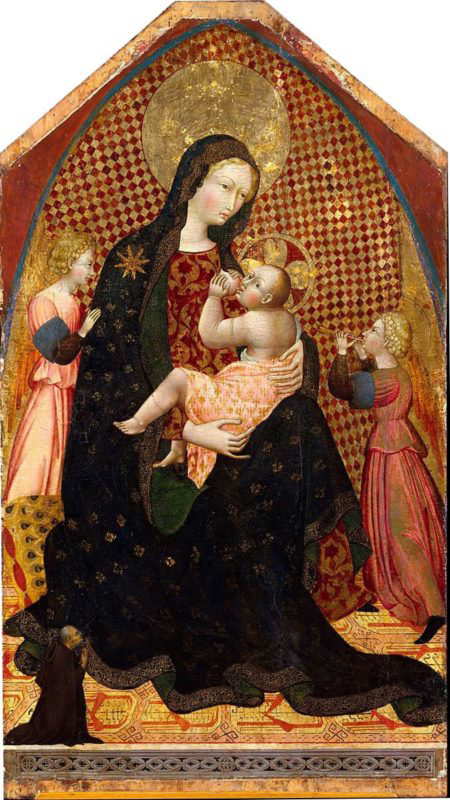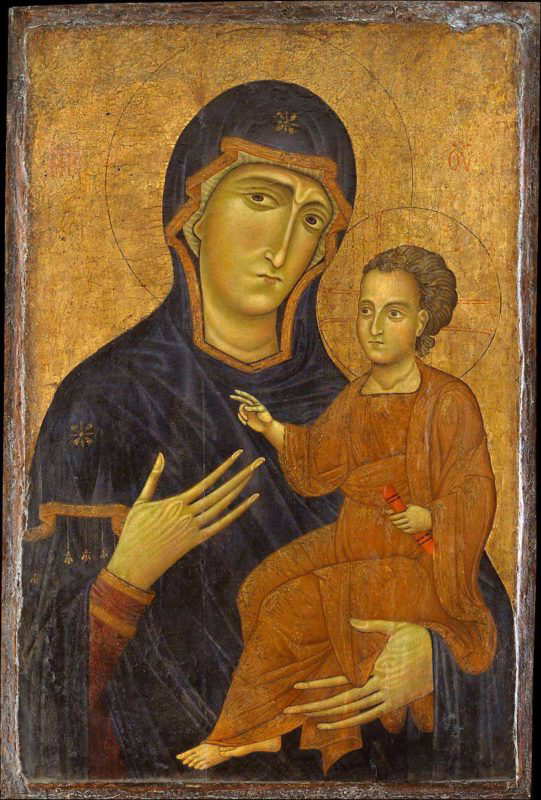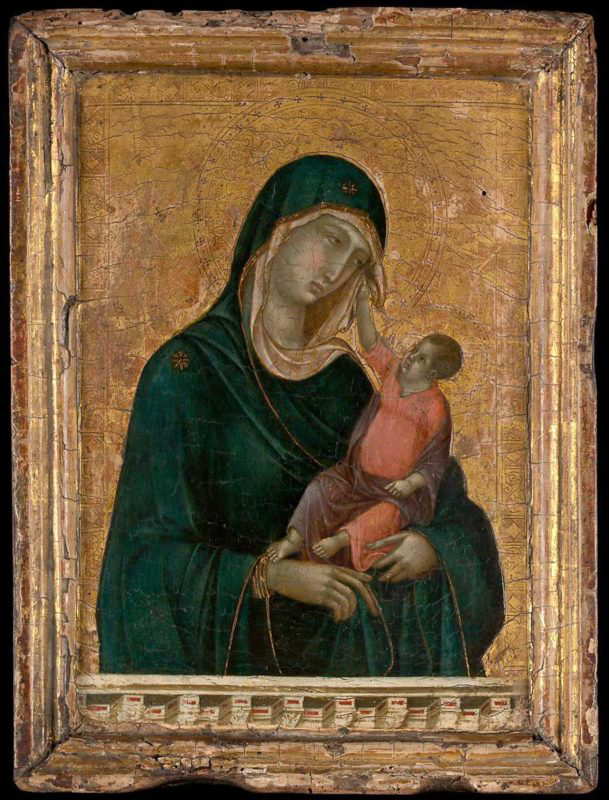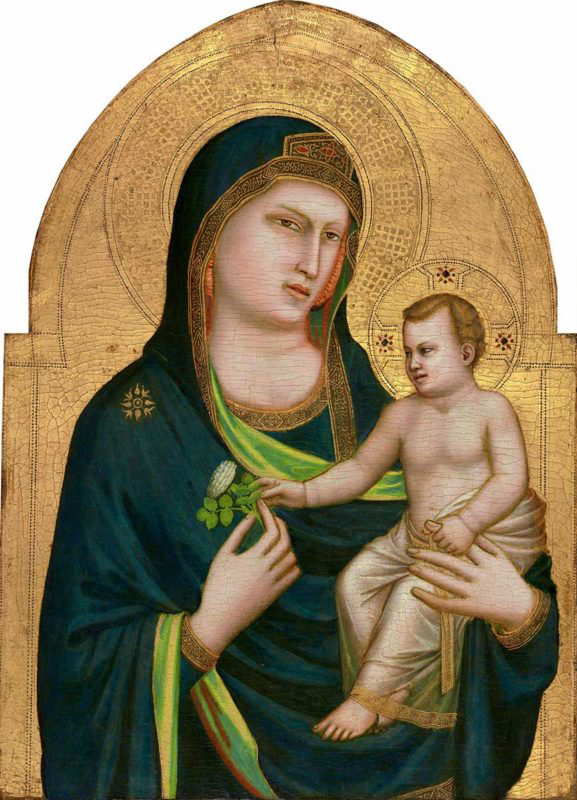
Religious iconography is not supposed to be a realistic depiction of the figures represented; instead, it is idealistic. One of the most famous icons was the Madonna and Child and yes, baby Jesus looking like an old man was the ideal. Here are some possible explanations as to why baby Jesus is always painted as an old man.
Before We Get To Baby Jesus, What Is Religious Iconography?

Painted and sculpted depictions of Gods and Goddesses have been around since antiquity. The word icon itself comes from the Greek word eikon. However, Christian iconography portraying religious figures started popping up around the 7th century.
Iconography are familiar images representing a larger message. For example, birds are a famous icon. In Christian art, doves represented the Holy Spirit. In works painted by Édouard Manet and Gustave Courbet in the 19th century, caged birds represented women trapped in social roles and confined in their homes, unable to live a truly independent lifestyle. Mary and the Christ Child in religious iconography represent eternal wisdom, knowledge, love, salvation, and the sacrifices Jesus will make later in life.
Why Did Artists Depict Baby Jesus As An Old Man?

In Medieval art, baby Jesus had the body of a baby but the face of a fully-grown man. Today, this can be very shocking and even hilarious. However, back in Medieval times, this was a typical depiction of baby Jesus in Medieval religious iconography. Baby Jesus doesn’t just represent a young version of Jesus, but the idea that Jesus was born already grown, all-knowing, and ready to change the world. While praying underneath a painting of Mary and her baby son, worshippers wanted the comfort of their prayers in the hands of someone who can help. An actual baby can’t do anything, but Jesus was always special, even at that age.
Get the latest articles delivered to your inbox
Sign up to our Free Weekly Newsletter
In some religious iconography, baby Jesus holds objects alluding to his eternal wisdom and knowledge. In Berlinghiero’s Madonna and Child, painted in the 13th century, baby Jesus is a tiny philosopher. He wears an ancient robe, holds a scroll, and has the face of a man with years of philosophical experience. Mary points to Jesus and stares directly at the viewer, showing whoever is worshipping that Jesus and his teachings are the way to salvation. In this example of religious iconography, baby Jesus represents the righteous path. Berlinghiero’s piece is also called the Virgin Hodegetria or The One Who Shows the Way.
Old Is The New Young: The Trend Of Homunculus

The term Homunculus is Latin for the little man. It is often attributed to the depiction of baby Jesus in these artworks.
Homunculus is the idea of a super small and fully formed human, who cannot be seen by the naked eye. Homunculus took a different turn in the 16th century when scholars believed super small humanoids existed. Even after debunked, it took a life of its own in popular culture in the 19th century, with Mary Shelley’s Frankenstein as a prime example.
The Bond Between Mother And Child

In these Medieval religious iconographies, Mary keeps her baby close and presents him to the viewer. In these early artworks from the early 13th century, Mary and her child are stiff and lack emotion and all the focus is on baby Jesus rather than Mary and her role as his mother. She is showing her child off to the viewer without warmth, just duty.
An example of these early scenes is Madonna and Child painted by Paolo Veneziano in the mid 14th century. This depiction of a mother and her child lacks love and compassion. Veneziano was more interested in symbolism rather than real emotions and physical traits. The Christ child holds a palm branch, which symbolizes his later visit to Jerusalem. The finch in Mary’s hand represents thorns, like the crown Jesus wore in the moments leading to his death. Symbolism is essential; that is why religious iconography exists. However, it’s possible to have naturalism in religious iconography.

Duccio di Buonisnsegna’s Madonna and Child painted in the late 13th century, is a more naturalistic scene. Mary looks lovingly at her child, her face soft and tender. Even though his face resembles a weathered middle-aged trucker, baby Jesus is softer with chubby cheeks and an innocent gaze. Baby Jesus stares into his mother’s eyes and gently plays with her veil, different from the other baby Jesus depictions. In Buonisnsegna’s work, there is more of an effort to create a naturalistic scene.
Depictions Of The Christ Child During The Renaissance

The Medieval period in Europe lasted from 5th century to the 15th. The depiction of baby Jesus changed in the 14th century.
The Renaissance translates to rebirth and focuses explicitly on the rebirth of classical ideals in art and society, including naturalism. Renaissance artists developed individual styles and welcomed perfect symmetry and classically ideal figures with natural expressions and realistic emotions. In 14th century Italy, the Church wasn’t the only organization to support the arts. Citizens were rich enough to commission artists to create artworks depicting their babies. These patrons wanted their children to look like children and not have the face of their grandparents.
In the 14th century, Giotto, a leader of the early Renaissance, painted his Madonna and Child. Giotto was one of the first painters interested in naturalism. What is impressive about this piece is the elements of naturalism, even in baby Jesus’s mature face. Mary and baby Jesus’ garments naturally flow around their bodies. Both Mary and Christ are fleshy and dimensional. However, the Christ child has a wide body, a semi-formed six-pack, and a midwestern butcher’s hairline.
After Giotto, baby Jesus became even more naturalistic. Great artists like Raphael, Leonardo da Vinci, and Jan Van Eyck in the North ushered in naturalistic Madonna and Child paintings that differ widely from early Medieval artworks.

It’s difficult to talk about Madonna and Child paintings without talking about Leonardo da Vinci’s Virgin of the Rocks. This painting is a Renaissance masterpiece, naturalistic, and pleasing to the eye. Da Vinci places Mary and Jesus in a beautiful landscape. Instead of floating in ethereal golden space, Mary and the Christ child are a part of nature and Earth’s beauty. Also, Jesus actually looks like a cute child!
Modern Religious Iconography And Depictions Of Baby Jesus

As art modernized, so did Mary and baby Jesus. In the 18th century, there was another rebirth of classical ideals in France’s Neoclassicist period. Artist William-Adolphe Bouguereau uses the Neoclassicist style in the late 19th century with his Madonna and Child. The golden halos and Mary’s robe are a nod to Medieval artworks. However, there are some differences. The background is in the impressionist style, Mary sits on a classically-inspired white marble throne, and baby Jesus looks like an actual child. Both Mary and the Christ child have soft and beautiful qualities. Bouguereau wanted Mary and baby Jesus to feel familiar to the viewer as if Mary and Jesus can be any modern mother and son.

The surrealist movement of the early 20th century centered around the subconscious inspired by the work of Sigmund Freud. Freud had a lot to say about the relationship between a mother and her son and surrealist painters responded to Freud’s teachings. One of the most famous surrealist painters was Spanish painter, Salvador Dalí. One of his later works was his The Madonna of Port Lligat. In true Dalí style, the figures are floating in some realm, not of this Earth. Mary resembles a modern woman, this time older and not the young mother depicted in Medieval religious iconography. Baby Jesus hovers in front of her, his stomach open with a torn piece of bread in the middle. This artwork contains symbolism relating to the holy mother and child as the bread represents Christ’s body.

In the 1960s, Andy Warhol ushered in the pop art movement, an artistic movement highlighting the horrors and delights of capitalism and mass production. In Allan D’Arcangelo’s Madonna and Child, D’Arcangelo depicts a faceless Jackie and Caroline Kennedy. Both figures have halos and bright colored clothes, a Pop-art staple. D’Arcangelo accomplishes what pop artists set out to do, make popular icons into Gods. Similar to what Medieval artists were doing when they painted icons of Mary and the Christ child, making religious and holy figures permanent on canvas or wood.

It’s true, Medieval depictions of baby Jesus as a little old man are funny! However, Medieval artists had a reason to paint baby Jesus as an old and wise man ready to change the world. As art modernized, depictions of baby Jesus and his mother became more naturalistic to fit with the desire for religious figures to become more relatable instead of unattainable. Nevertheless, looking at images of Medieval baby Jesus does make the day a little more enjoyable.







